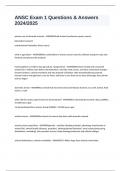ANSC Exam 1 Questions & Answers
2024/2025
primary use of domestic animals - ANSWERSdraft animals (nonhuman power source)
biomedical research
entertainment industries (horse races)
what is agriculture - ANSWERSthe combination of science and art used to cultivate and grow crops and
livestock and process the products
hunter-gathers to modern day agriculture. (progression) - ANSWERShumans hunted and consumed
animals for 2 million years before domestication; used the meat, bones, and skins; behavioral changes-
became farmers; cultural revolution and step towards civilization, after domesticationing animals,
humans had to manage them, care for them, and learn to use them to our best advantage; thus animal
science began
domestic animal - ANSWERSan animal that has been tamed and kept by humans as a work animal, food
source, or pet
when did the various species become domesticated - ANSWERS1st domesticated animal: dog 12,000B.C.
(14,000 years ago)
1st domesticated farm animal: sheep 8,000B.C. (10,000 years ago)
animal science - ANSWERSthe branch of science that deals with domestic animals
animal science specialites - ANSWERSgenetic , nutrition (feeding animals), physiology (mechanism of
animal life), animal health (diseases, parasites), ethology(animal behavior), meat science(processing,
distribution, marketing), dairy product science, biotechnology(molecular and cellular biology)
animal distributions: animals worldwide - ANSWERS4.9 billion large farm animals world wide
,22.9 billion poultry
1.4 billion cattle
1.08 billion sheep
93 million pigs
84 million goats
109 million horses, asses, and mules
animal contributions to mankind - ANSWERSfood: meat, milk, blood, and fat
body coverings: wool, leather, belts, and hides
work: field work and transportation
body wastes: fuel, fertilizer (N-P-K), construction material, and feed
other: capital storage, income, prestige, religion, by-products, recreation, and research
plant vs. animal food as sources of energy and protein in U.S. vs. world: - ANSWERSWorldwide: plants:
82.3 energy, 62% protein
U.S.: plants: 73% energy, 36% protein
Worldwide: animals: 17.7% energy, 38% protein
U.S.: animals: 27% energy, 64% protein
animals are a more important source of protein than they are of calories, supplying 40% of the proteins
consumed in the world
of the animal proteins sources: meat supplies app. 48.4%; milk supplies app. 26%;fish supplies app. 17%;
; egg supplies 8.6%
relative contribution of animal protein - ANSWERSmeat, eggs, and dairy products are important food
source because they are nutrient dense
animal foods are an important source of vitamins and mineral and protein in animal foods is more likely
than are plant proteins to include essential amino acids in the correct proportions
nutrient dense - ANSWERSa measure of the chemical substances of food that provides nourishment as
compared to the calories
, essential amino acids - ANSWERSthe smallest complete unit of a protein that is required by the body but
can't be manufactured at a rate needed for growth, reproduction, or milk production
draft animal - ANSWERSone that is used to aid in work/labor
which animal is most important source of meat - ANSWERSpig
other uses of animals - ANSWERSbiomedical research with animals-30 additional years of life since 1990
specially trained animals assit people with visual, hearing and other disabilities
biofuel production plays a role in food availability and price
animals convert inedible feeds to valuable food for humans
2/3 of animal foods aren't suitable for human consumption (hay, pasture, coarse forages, by-products,
garbage, damaged feed)
domestication - ANSWERSprocess by which humans take wild species, acclimatize them to breed and
survive in captivity
why we eat meat - ANSWERSnatural: foundation in human biology
normal: most people eat meat and expected behavior
necessary: need to eat to survive or to thrive, stay healthy, and be properly nourished
nice: enjoyable because meat tastes good
food uses of animal products - ANSWERSmeat: nutrients provided by meat are important for human
survival
protein and energy: proteins (amino acids); energy measured as calories
vitamins: fat and water soluble
minerals: macro and micro minerals
essential fatty acids: linoleic and linolenic acid




